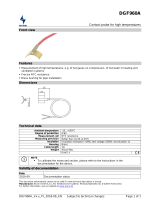
ENG
WARNINGS
CAREL bases the development of its products on decades of experience in
HVAC, on the continuous investments in technological innovations to products,
procedures and strict quality processes with in-circuit and functional testing on
100% of its products, and on the most innovative production technology
available on the market. CAREL and its subsidiaries/affiliates nonetheless
cannot guarantee that all the aspects of the product and the software included
with the product respond to the requirements of the final application, despite
the product being developed according to start-of-the-art techniques. The
customer (manufacturer, developer or installer of the final equipment) accepts
all liability and risk relating to the configuration of the product in order to reach
the expected results in relation to the specific final installation and/or
equipment. CAREL may, based on specific agreements, acts as a consultant for
the positive commissioning of the final unit/application, however in no case
does it accept liability for the correct operation of the final equipment/system.
The CAREL product is a state-of-the-art product, whose operation is specified in
the technical documentation supplied with the product or can be downloaded,
even prior to purchase, from the website www.carel.com.
Each CAREL product, in relation to its advanced level of technology, requires
setup/configuration/programming/commissioning to be able to operate in the
best possible way for the specific application. The failure to complete such
operations, which are required/indicated in the user manual, may cause the
final product to malfunction; CAREL accepts no liability in such cases.
Only qualified personnel may install or carry out technical service on the
product. The customer must only use the product in the manner described in
the documentation relating to the product.
In addition to observing any further warnings described in this manual, the
following warnings must be heeded for all CAREL products:
• Prevent the electronic circuits from getting wet. Rain, humidity and
all types of liquids or condensate contain corrosive minerals that
may damage the electronic circuits. In any case, the product should
be used or stored in environments that comply with the
temperature and humidity limits specified in the manual.
• Do not install the device in particularly hot environments. Too high
temperatures may reduce the life of electronic devices, damage
them and deform or melt the plastic parts. In any case, the product
should be used or stored in environments that comply with the
temperature and humidity limits specified in the manual.
• Do not attempt to open the device in any way other than described
in the manual.
• Do not drop, hit or shake the device, as the internal circuits and
mechanisms may be irreparably damaged.
• Do not use corrosive chemicals, solvents or aggressive detergents
to clean the device.
• Do not use the product for applications other than those specified
in the technical manual.
All of the above suggestions likewise apply to the controllers, serial boards,
programming keys or any other accessory in the CAREL product portfolio.
CAREL adopts a policy of continual development. Consequently, CAREL
reserves the right to make changes and improvements to any product
described in this document without prior warning.
The technical specifications shown in the manual may be changed without
prior warning.
The liability of CAREL in relation to its products is specified in the CAREL
general contract conditions, available on the website www.carel.com and/or by
specific agreements with customers; specifically, to the extent where allowed by
applicable legislation, in no case will CAREL, its employees or subsidiaries be
liable for any lost earnings or sales, losses of data and information, costs of
replacement goods or services, damage to things or people, downtime or any
direct, indirect, incidental, actual, punitive, exemplary, special or consequential
damage of any kind whatsoever, whether contractual, extra-contractual or due
to negligence, or any other liabilities deriving from the installation, use or
impossibility to use the product, even if CAREL or its subsidiaries are warned of
the possibility of such damage.
DISPOSAL
Disposal of the product
The appliance (or product) must be disposed of separately
in compliance with the local standards in force on waste
disposal.





















